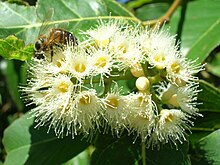Eucalyptus deglupta
| Rainbow eucalyptus | |
|---|---|

| |
| Eucalyptus deglupta bark | |
| Scientific classification | |
| Kingdom: | Plantae |
| Clade: | Tracheophytes |
| Clade: | Angiosperms |
| Clade: | Eudicots |
| Clade: | Rosids |
| Order: | Myrtales |
| Family: | Myrtaceae |
| Genus: | Eucalyptus |
| Species: | E. deglupta
|
| Binomial name | |
| Eucalyptus deglupta | |
| Synonyms[1] | |
| |
Eucalyptus deglupta is a species of tall tree, commonly known as the rainbow eucalyptus,[2] Mindanao gum, or rainbow gum[3] that is native to the Philippines, Indonesia, and Papua New Guinea. It is the only Eucalyptus species that usually lives in rainforest, with a natural range that extends into the northern hemisphere and is one of only four eucalypt species out of more than seven hundred that do not occur in Australia. It is characterized by multi-colored bark.
Description


Eucalyptus deglupta is a fast-growing tree that typically reaches a height of 60–75 m (197–246 ft) with the trunk up to 240 cm (94 in) in diameter and with buttresses up to 4 m (13 ft) high. It has smooth, orange-tinted bark that sheds in strips, revealing streaks of pale green, red, orange, grey, and purplish brown. The branchlets are roughly square in cross section, often with narrow wings on the corners. The leaves are arranged in opposite pairs, mostly 75–150 mm (3.0–5.9 in) long and 50–75 mm (2.0–3.0 in) wide on a short petiole. The flower buds are arranged in a branching inflorescence in leaf axils, or on the end of branchlets, each branch with groups of seven buds, the individual buds on a pedicel about 5 mm (0.20 in) long. Mature buds are pale green or cream-colored, roughly spherical in shape and 2–5 mm (0.079–0.197 in) in diameter with a hemispherical operculum with a small point on the top. Flowering time depends on location, and the stamens that give the flowers their colour are white and pale yellow. The fruit is a woody, brown, hemispherical capsule about 3–5 mm (0.12–0.20 in) long and wide, with three or four valves extending beyond the rim of the fruit. Each cell of the fruit contains between three and twelve minute brown seeds, each with a small wing.[4][5]
Taxonomy and naming
Eucalyptus deglupta was first formally described in 1850 by Carl Ludwig Blume who published the description in his book Museum Botanicum Lugduno-Batavum sive stirpium Exoticarum, Novarum vel Minus Cognitarum ex Vivis aut Siccis Brevis Expositio et Descriptio from a specimen collected in the Celebes.[1][6] The specific epithet (deglupta) is a Latin word meaning "peeled off, husked or shelled".[7]
Distribution and habitat
The rainbow eucalyptus grows in lowland and lower montane rainforest from sea level to altitudes of up to 1,800 m (5,900 ft). It is native to Indonesia, Papua New Guinea, and the Philippines, but has been widely planted in many other countries.[4]
Uses
This tree is grown widely around the world in tree plantations, mainly for pulpwood used in making white paper. It is the dominant species used for pulpwood plantations in the Philippines.[8] E. deglupta are commonly planted as ornamental trees in frost-free climates such as Hawaii, Southern California, Texas, and Louisiana.[9]

Horticulture
If grown from seed, the temperature should be around 68–72 °F (20–22 °C).[10] Plants can be grown from cuttings of trees younger than 5 years old. Once a tree reaches 5 years of age, root inhibition prevents the generation of roots from cuttings.[11] It thrives in rich medium-to-wet soil in full sun and is intolerant of frost.[12] In botanical gardens such as Fairchild Tropical Botanic Garden in Florida, the tree does show the intense color range as seen in the tree's normal range.[13][14]
References
- ^ a b c "Eucalyptus deglupta". World Checklist of Selected Plant Families (WCSP). Royal Botanic Gardens, Kew.
- ^ "UFEI - SelecTree: A Tree Selection Guide". selectree.calpoly.edu. Retrieved 29 April 2018.
- ^ "Rainbow Gums". Double Helix. CSIRO. Retrieved 8 August 2017.
- ^ a b "Eucalyptus deglupta" (PDF). World of Forestry. Retrieved 28 May 2019.
- ^ "Eucalyptus deglupta". Missouri Botanical Garden. Retrieved 28 May 2019.
- ^ Blume, Carl Ludwig (1850). Museum Botanicum Lugduno-Batavum sive stirpium Exoticarum, Novarum vel Minus Cognitarum ex Vivis aut Siccis Brevis Expositio et Descriptio. pp. 83–84. Retrieved 28 May 2019.
- ^ Brown, Roland Wilbur (1956). The Composition of Scientific Words. Washington, D.C.: Smithsonian Institution Press. p. 716.
- ^ "Notes on Eucalyptus" (PDF). National Resources Institute. Archived from the original (pdf) on 27 September 2007. Retrieved 10 January 2007.
- ^ "Rainbow Eucalyptus Tree – Learn About Rainbow Eucalyptus Growing Conditions". www.gardeningknowhow.com. Retrieved 29 April 2018.
- ^ Caines, Kimberley. "Germination of a Eucalyptus Deglupta". SFGate. Retrieved 31 October 2019.
- ^ Davidson, John (1973). "Reproduction of Eucalyptus deglupta by cuttings" (PDF). New Zealand Journal of Forestry Science. 4: 191–204.
- ^ "Eucalyptus deglupta - Plant Finder". www.missouribotanicalgarden.org. Retrieved 29 April 2018.
- ^ Garner, LariAnn. "Under the Rainbow" (pdf). Retrieved 10 January 2007.
- ^ David Webster Lee (2007). Nature's palette: the science of plant color. University of Chicago Press. p. 228. ISBN 9780226471051. Retrieved 22 April 2011.
